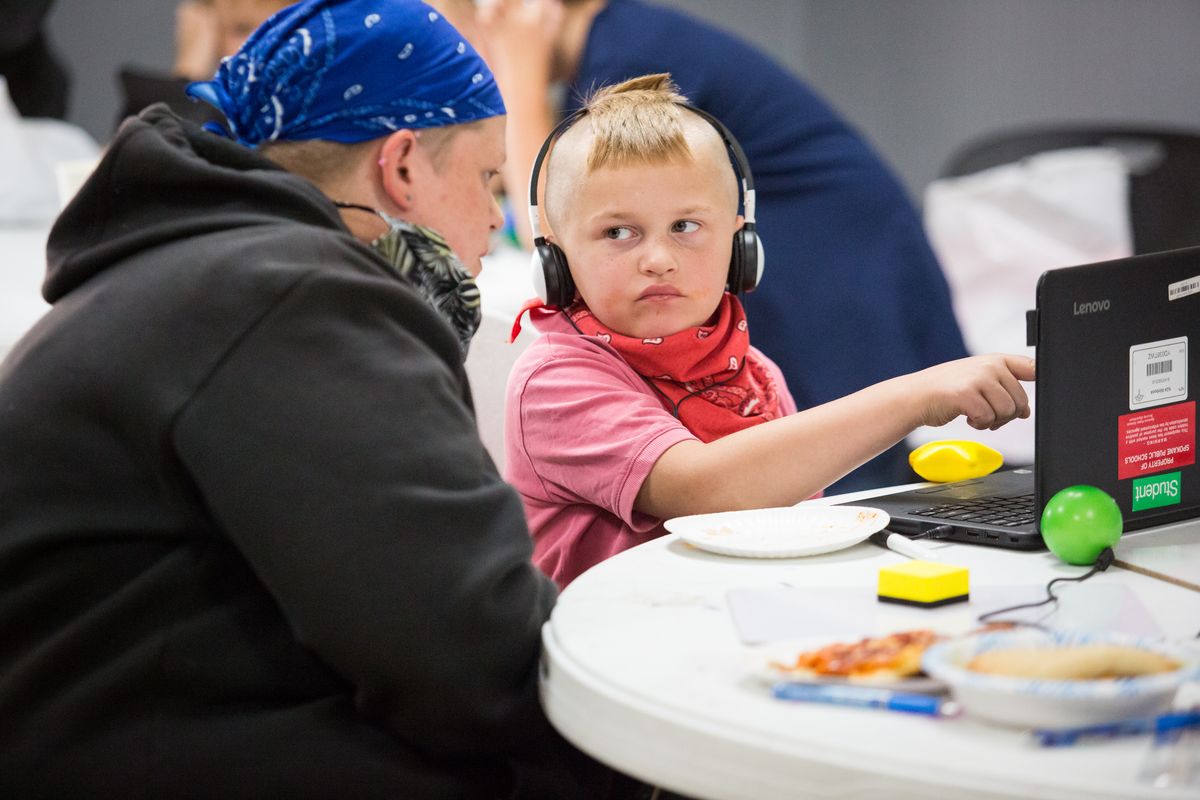Homeless children in Spokane struggle to keep up during distance learning

In a small room at the Open Doors homeless shelter in north Spokane, 6th-grader Christopher Longstreet is trying to study.
On his laptop screen are the faces of his teacher and classmates at Logan Elementary, the neighborhood school that’s only a mile away.
But in the age of the coronavirus, it might as well be a hundred.
Two seconds later, a toddler down the hall lets out a cry loud enough to lift the heads of Christopher and everyone else in the room,
“It’s been hard,” said his mother, Michelle, who’s feeling utterly inadequate. “He’s a very smart kid, and I’m trying to keep him on track, but it’s so tough.”
That was a month ago.
While some classmates have been placed in day camps operated by Spokane Public Schools, Christopher is still there, trying to make the most of this purgatorial journey into distance learning.
His classmates are there too – virtually – but they’re sleeping in the same bed and living under the same roof they’ve known for years.
For all the inconveniences forced upon schoolchildren and their families by the COVID-19 pandemic, it’s far worse for the homeless. It’s another uprooting of lives that have known little else.
There are about 3,000 “hidden homeless” children in Spokane County, according to Joe Ader, director of Family Promise of Spokane, which operates two family shelters.
Not officially homeless, they are the kids who live in their cars or couch-surf at the homes of friends and relatives.
The lucky ones have been placed in housing such as the two homeless shelters operated by Family Promise of Spokane, but many more are still waiting.
Already at high risk for academic failure, they usually lack internet connectivity, laptops and other support.
The district, along with internet provider Comcast, has tried to reach out with free and reduced-cost wireless access.
But that’s not enough, an insufficient replacement for a lost lifeline to school buildings, where prior to the pandemic teachers and staff were often the first to raise the alarm about food insecurity, neglect, abuse and other issues.
“Our schools are the hubs of our neighborhoods,” said Adam Swinyard, superintendent of Spokane Public Schools. “They’re the heartbeat of our neighborhood. So we recognize that not having our school buildings open is going to require us to be very, very thoughtful, to do everything we can to make sure those students get the support they need.”
However, Spokane is taking a cautious approach to reopening buildings. Currently, only kindergartners and some special-needs students are back.
And because students aren’t required to turn on their cameras during virtual lessons, it’s difficult for staff to monitor a child’s behavior and watch for signs of trouble.
“A lot of kids are falling through the cracks,” said Ader, who has 31 children in the two shelters.
Federal data from 2019 highlights the significant barriers to academic success faced by students experiencing homelessness.
Nationally, only 29% of students experiencing homelessness achieved academic proficiency in reading (language arts), 24% achieved proficiency in mathematics and 26% achieved proficiency in science. Graduation and proficiency rates for homeless students are significantly below economically disadvantaged students.
Those at the Open Doors facility, formerly known as Cassano’s Grocery, are trying to stay focused. Seated at socially distanced tables, they work on and off for 3 hours as moms sit nearby.
Kelsi Telquist says she’s doing her best to keep 8-year-old Jessie and 6-year-old Kobie “in line and on the computer.”
Telquist said the educational experience is better than the last spring.
“But when you don’t pay attention, they go off and play games on the computer,” Telquist said.
At the next table sits Becca Wells, a single mother of three who defies the homeless stereotype.
She’s articulate and focused on the future, one that seemed bright after she earned an associate’s degree in business last year at Spokane Falls Community College.
“I was trying to do what I could since graduation, trying to land on my feet,” Wells said.
Then she lost her apartment in East Farms, just west of the Idaho border, in a lease dispute with a roommate.
Then came COVID-19 and the statewide shutdown of schools on March 17.
Three days earlier, Wells moved into the Union Gospel Mission with 8-year-old Orion, 6-year-old Ophelia and 4-year-old Avery.
Ophelia held on to her mother as Becca spoke in the noisy hallway.
“She was in kindergarten last year, so she didn’t get to be in school like most kids do,” Wells said as she also considered the challenges facing Orion, who is autistic.
“That makes things a little interesting,” Wells said.
Fortunately, she’s getting a break because her school district, East Valley, operates on a hybrid model that allows her children to attend every other day and learn virtually the rest of the time.
Trying to stay positive about the future, Wells is trying to impart the same attitude in her children.
“I’m trying to do what I can to keep them focused,” Wells said. “It’s just about positive reinforcement.”